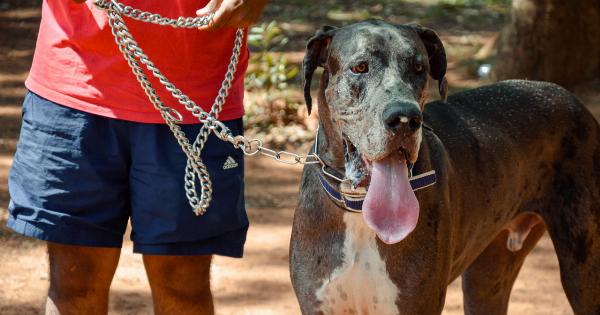As the temperatures drop and winter settles in, it’s important to pay extra attention to your furry friend’s paws during those chilly walks.
Cold weather can be harsh on your dog’s sensitive paws, leading to dryness, cracks, and even frostbite. To ensure your dog stays happy and healthy throughout the winter season, follow these tips for protecting their paws:.
1. Keep nails trimmed
Long nails can make it difficult for your dog to walk properly and can cause paw pads to splay, making them more susceptible to injuries and ice buildup. Regular nail trimming is crucial to prevent such problems.
If you’re unsure how to do it yourself, consult a professional groomer or a veterinarian.
2. Moisturize paw pads
Just like our skin can get dry and cracked in cold weather, dog paw pads can also suffer from dryness. Applying a pet-safe moisturizer or paw balm on a regular basis can help keep their paw pads hydrated and protected.
Look for products that are specifically designed for dogs and avoid using human lotions or creams.
3. Use protective balms
In addition to moisturizing, consider using protective balms or waxes on your dog’s paws before heading out for a walk. These products create a barrier between their paws and the cold pavement, helping to prevent irritation and damage.
Be sure to choose a balm that is pet-safe and apply it as directed.
4. Booties are a great option
If your dog is willing to wear them, booties can provide the ultimate protection against cold weather.
They not only protect your dog’s paws from icy sidewalks but also prevent contact with chemicals, salt, and de-icing agents that can be harmful to them. Make sure to introduce booties gradually, allowing your dog to get used to them before venturing out for a long walk.
5. Avoid salted areas
Many roads and sidewalks are treated with salt during winter to melt ice and snow. While it’s effective for melting, it can be harmful to your dog’s paws. Salt can cause irritation, burns, and even poisoning if ingested.
Whenever possible, try to steer clear of salted areas or rinse your dog’s paws with warm water and dry them thoroughly after a walk.
6. Watch out for ice balls
Ice balls can form between your dog’s toes and pads, causing discomfort and potential injury. To prevent this, regularly check your dog’s paws for ice buildup during walks.
If you notice any ice balls, remove them gently to avoid causing pain or damage. Trimming the hair around your dog’s paws can also help reduce the formation of ice balls.
7. Consider using paw pads wax
Paw pad wax is another option to protect your dog’s paws from the cold and harsh weather. It forms a protective layer on their paws, shielding them from ice, snow, salt, and other irritants.
Applying wax before walks can help minimize paw pad damage and keep your dog comfortable and happy.
8. Opt for shorter walks
In extremely cold weather conditions, it may be wise to shorten your regular walks. Limiting exposure to the cold will reduce the chances of your dog’s paws getting frostbite or frostnip.
Adjust the duration and intensity of your walks based on the weather and your dog’s tolerance to low temperatures.
9. Consider indoor activities
In particularly cold or inclement weather, it’s a good idea to engage your dog in some indoor activities instead of going for a walk.
Play interactive games, practice obedience training, or use puzzle toys to keep them mentally and physically stimulated. Indoor exercises are a great way to bond with your furry friend while keeping them safe from the cold.
10. Consult your veterinarian
If you notice any unusual signs or persistent issues with your dog’s paws during winter, it’s essential to seek advice from your veterinarian.
They can examine your dog’s paws, recommend appropriate treatments or products, and provide specific guidance based on your dog’s breed, age, and health condition.






























